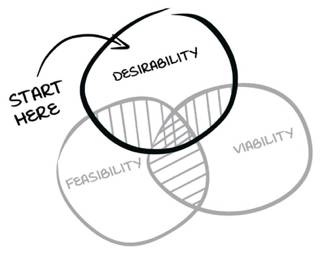Learn the Principles of Design Thinking
Learning Objectives
After completing this unit, you’ll be able to:
- Define design thinking.
- Explain the core principles of design thinking.
- Explain how design thinking can be a helpful approach to complex problem solving.
What Is Design Thinking?
Design thinking is a creative problem-solving process used to find novel solutions. In the past, it was used by city planners and architects to create urban spaces and buildings for people. In the 1980s it moved into the world of business and was used primarily for products designed by companies like Apple. Today, design thinking is used by the world’s leading companies to create not only product solutions, but also services, experiences, and business models.
Companies like IBM and SAP have made significant investments over years to hire designers and build design capabilities within their organizations. Or they have acquired design firms. And start-ups now use it to disrupt their industries and achieve growth.
As a problem-solving process, design thinking has several core principles that distinguish it from traditional, more linear approaches used in business. In traditional approaches, people define a problem, generate solution ideas, and seek to implement those—pretty straightforward. And for most problems, this approach has worked well. However, for complex problems or for situations that require new and innovative solutions, linear problem solving tends to fall short.
Take On a New Perspective
Most business people take on one of the following perspectives when trying to solve a problem.
-
Feasibility perspective focused on technologies and tools they can use to address a need or opportunity
-
Viability perspective focused on a given business strategy of a financial target
While these are important, they ignore desirability, or who the user is, what they care about, and why. Design thinking is often referred to as human-centered design, because designers always start their approach by looking at the people and their needs before considering feasibility and viability perspectives.
Research to Build Empathy

The design process begins with establishing a deep empathy for, and understanding of, the end user. End users are the people who will be most impacted, or those who will use the eventual solution. For example, if you want to create a new medical device, the end users can include both healthcare providers—physicians—and their patients. You’d spend time in the field with physicians and patients, talking with them about their experiences, observing existing treatments and interactions along the patient journey. You do this in order to deeply understand what people are seeking to accomplish at various stages of that journey, and why those goals are important.
The benefits of this research is that you expand and deepen your understanding of user needs. This leads to insights that inspire novel ideas. Research also increases the likelihood that your solution will be adopted because it’s anchored in the needs of the people who will eventually use it.
By addressing desirability, you increase the likelihood that feasibility and viability requirements can be met because users are willing and able to engage with the solution.
Iterate on Ideas
Once a design team has new solution ideas to work with, another core principle is the rapid iteration of solution ideas while closely involving users. Rather than investing time and effort in drafting a comprehensive implementation plan to be executed, start small with rough prototypes of the solution and immediately engage users to get fast feedback. Evolve the solution in a collaborative manner. These experiments occur rapidly and eventually grow to test for feasibility and viability until a pilot phase.
One medical device team, working on a tool for nasal surgery, began their prototyping by duct-taping markers and clothespins together and asking physicians to handle the prototype and offer their critiques. With immediate feedback, the design team was able to quickly refine their ideas to create a device physicians liked (desirability), that addressed an unmet need for nasal surgeries (feasibility), and that could be sold by a medical device firm to achieve profit targets (viability). This approach to implementation reduces the risk of missing important solution features while ensuring adoption.
Design Past Assumptions
Design thinking, as a problem-solving process, can be an extremely valuable approach to solve complex problems. In many cases, people aren’t clear on what the problem or opportunity actually is. Their assumptions outweigh their knowledge.
Design thinking helps increase confidence both in understanding the current state as well as providing new solutions that will address desirability, feasibility, and viability issues in the future. Design thinking may not be useful or necessary for simpler problems, or when people are fixated on a prescribed solution.
So, how does design thinking apply to sales?
